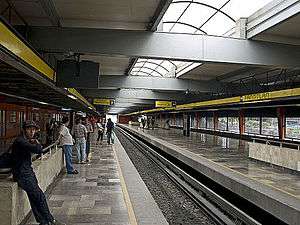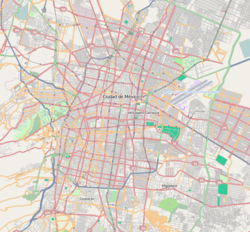Metro Pantitlán
Metro Pantitlán is a station on the Mexico City Metro.[2] It is located in the Iztacalco borough, to the east of downtown Mexico City. The architects were Aurelio Nuño Morales and Isaac Broid.[3] In 2019, the station had an average ridership of 397,777 passengers per day, making it the busiest station in the entire network.[4]
General information
The station logo is the silhouette of two flags; this is because Pantitlán means "between flags" in the Aztec language Nahuatl.[5]
Pantitlán is the most important transfer station on the Mexico City Metro. It is the terminal for Lines 1, 5, 9 and A and has the highest user-traffic of the whole metro system. It is also one of the largest stations in the world, connecting four Metro lines, a trolleybus line (STE route Q), and around a hundred bus lines. It is the closest station to Terminal 2 of Mexico City International Airport, which is a 700 m walk away. Because of its large size and improvised design, it is important to follow the signs to the different platforms. The link with Line A allows Mexico State (Estado de México) inhabitants to travel to Mexico City faster and cheaper than by bus or other kinds of transportation. The station was opened for service along Line 5 on 19 December 1981, along Line 1 on 22 August 1984, along Line 9 on 26 August 1987, along Line A on 12 August 1991.[6]
Some curiosities are that all Metro lines except for the A and 12 use pneumatic traction (rubber-tired trains) and gather electricity from a third rail; trains on Lines A and 12 use traditional rail traction, and gather electricity with a pantograph, from overhead wires. In addition, scenes for the 1990 motion picture Total Recall were filmed in the corridors and platforms of Metro Pantitlán.
Nearby
- Terminal 2 of the Mexico City International Airport
Exits
Line 1
- Alberto Braniff street and Avenida Miguel Lebrija, Colonia Aviación Civil
Line 5
- South: Avenida Miguel Lebrija, Colonia Aviación Civil
- North: Alberto Braniff street, Colonia Aviación Civil
Line 9
- West: Avenida Río Churubusco, Colonia Ampliación Adolfo López Mateos
- East: Avenida Miguel Lebrija and Cerrada de Río Churubusco street, Pantitlán
Line A
- North: Avenida Río Churubusco and Talleres Gráficos street, Colonia Ampliación Adolfo López Mateos.
- Northwest: Avenida Río Churubusco and Guadalupe Victoria street, Pantitlán
- South: Avenida Río Churubusco, Pantitlán
Gallery
- Inside the Line 1 portion of Metro station Pantitlán above the tracks
- Metro Pantitán terminal serving Lines A and 9 of the Mexico City Metro system
- View of terminal platform at Pantitlán Line A section
References
- "Afluencia de estación por línea 2018" (in Spanish). Sistema Transporte Colectivo Metro. 2019. Archived from the original on 6 June 2019. Retrieved 7 April 2020.
- Archambault, Richard. "Pantitlán (Line A) » Mexico City Metro System". Retrieved 7 August 2011.
- Pantitlán Mexico Archived September 2, 2009, at the Wayback Machine
- "Estaciones de mayor afluencia 2019" (in Spanish). Metro CDMX. Retrieved 29 March 2020.
- Page on Pantitlán station from official Metro website (in Spanish) Archived 2008-06-26 at the Wayback Machine
- Monroy, Marco. Schwandl, Robert (ed.). "Opening Dates for Mexico City's Subway". Retrieved 15 August 2011.

